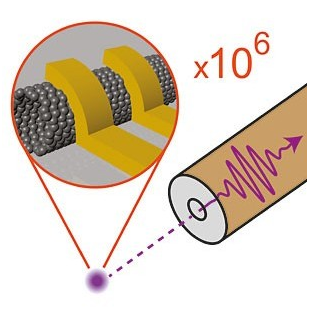Coupled Carbon Nanotubes Enable Efficient Signal Transmission from Nanocomponents
Coupled Carbon Nanotubes Enable Efficient Signal Transmission from Nanocomponents
Researchers at the Department of Physics and the Swiss Nanoscience Institute at the University of Basel, along with colleagues from ETH Zurich, have developed an efficient method to transmit signals from nanocomponents. In an innovative layout, they connected a nanocomponent to two electrical conductors which uncoupled the signal highly efficiently.

The clever arrangement of two electrical conductors around the carbon nanotube leads to an efficient signal transmission between the carbon nanotube and a much larger conductor for electromagnetic waves. © University of Basel, Department of Physics/Swiss Nanoscience Institute
The size of electronic components is decreasing. Research labs are capabile of producing nanoscale components with dimensions in the order of a couple of nanometers. This miniaturization capability allows placement of a significant number of electronic components even in restricted locations, contributing to better performance in future electronics components.
Many research groups around the world are trying to utilize carbon nanotubes for creating nanoscale components. Carbon nanotubes possess several distinct properties. They can be used as semiconductors or conductors as they have the ability to endure strong currents. They also provide outstanding heat conduction. Researchers have been facing problems in addressing the signal transmission loss between a carbon nanotube and an electrical conductor that is of a comparatively larger size. This loss occurs because part of the signal gets reflected.
Light sources inside glass objects also face similar issues. The walls of the object reflect most of the light, so only a small amount of the light escapes. Usage of an antireflex coating could help address this issue.
A similar method to address the problems faced in nanoelectronics is being undertaken by scientists in Basel. This endeavor is being led by Professor Christian Schönenberger. The team has created an antireflex device that would help decrease the reflection that occurs when transmission takes place from nanocomponents to larger circuits. A special formation of electrical conductors with a specific length was created and coupled with a carbon nanotube. This helped uncouple high-frequency signals efficiently from the nanocomponent.
However, the team faced difficulties in attaching nanostructures to conductors of a larger size. This was due to the dissimilar impedances. The transmission loss was proportional to the impedance difference between two conducting structures. The difference between macroscopic conductors and the nanocomponents is very high, and countermeasures are required to enable signal transmission. The antireflex device enables efficient coupling by adjusting the impedances and reducing the effect. This development advances the possibility of utilizing nanocomponents for transmitting signals in electronic parts.
The researchers have published the findings of their study as a paper titled “Clean carbon nanotubes coupled to superconducting impedance-matching circuits,” in the journal Nature Communications.

